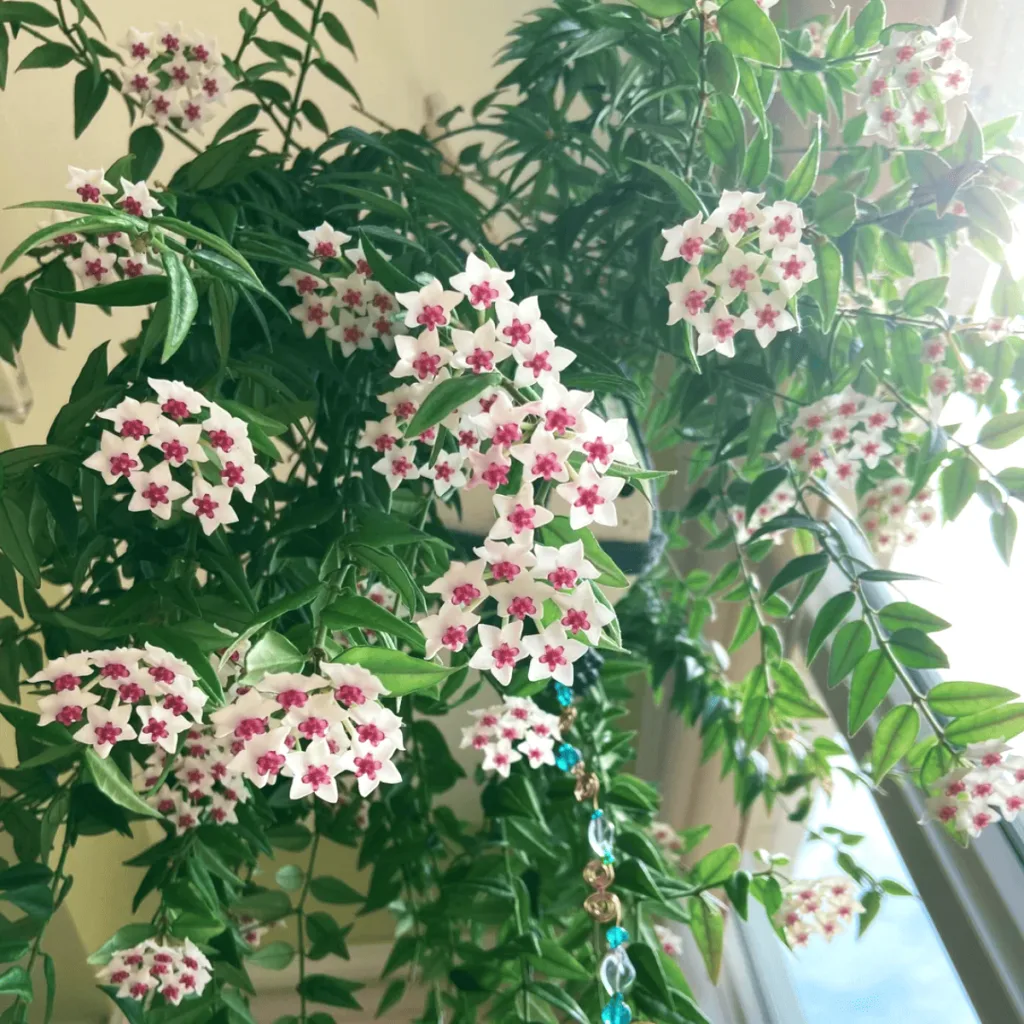Have you ever been drawn to a plant that just seems… different? That’s often the reaction people have to Hoya plants, also known as wax plants. These intriguing vines, with their often-glossy, sometimes-fuzzy leaves and star-shaped blooms, have captured the hearts of plant enthusiasts worldwide. But what is it exactly that makes them so special? We’re about to dive into the world of Hoyas, exploring their unique charm and the reasons why they’ve become such a beloved plant for both beginners and seasoned collectors. We’ll move beyond the basics, digging into the details that make them a standout addition to any plant lover’s collection.
The Allure of Hoya: More Than Just a Pretty Face
Hoya plants aren’t just another houseplant. They offer a captivating mix of beauty, diversity, and surprising resilience, a trifecta that pulls many people into their fragrant world. Let’s break down what makes these plants so compelling.
The Stunning Variety of Leaves
One of the first things that draws people to Hoyas is the sheer diversity in their leaf shapes and textures. It’s an entire botanical art show in one family of plants. Unlike many plants with similar foliage across the board, Hoyas come in a dizzying array of appearances.
- Shape Shift: You’ll find leaves that are oval, heart-shaped, lance-shaped, and even almost circular. The size varies dramatically too, from tiny, dime-sized leaves to large, hand-sized specimens.
- Texture Tales: Beyond shape, the surface of a Hoya leaf can be smooth and glossy, like polished jade, or fuzzy and soft, with a velvety feel. Some even have intricate veining patterns that add to their unique look.
- Color Canvas: While most Hoyas are known for their various shades of green, many have splashes of silver, pink, or even deep purple. Some species even blush red when they receive enough sunlight, making each plant a living masterpiece.
The Exquisite Bloom: A Starry Spectacle
The flowers of Hoyas, often referred to as their “umbels,” are perhaps their most distinctive feature. These clusters of star-shaped blossoms look like something out of a fairytale.
- Unusual Forms: Instead of the typical single flower, Hoyas produce groups of tiny, waxy flowers that form perfect circles or half-spheres. It’s a botanical firework display!
- A Rainbow of Hues: The flower color varies wildly, from pristine white to vibrant pink, deep red, yellow, orange, and even near-black. There’s a Hoya blossom for almost every color preference.
- Fragrant Delight: Many Hoya flowers are not just visually stunning, but also incredibly fragrant. They often release their sweetest perfumes in the evening, filling your home with a delightful and unexpected scent.
The Low-Maintenance Charm
Despite their exotic appearance, Hoyas are surprisingly easy to care for, making them a great choice for both beginner plant parents and busy individuals.
- Drought Tolerant: Hoyas are succulents, meaning they are naturally drought-tolerant and prefer to dry out between waterings. This helps prevent overwatering, one of the most common mistakes for plant enthusiasts.
- Versatile Lighting: They can thrive in a range of lighting conditions, from bright, indirect light to lower-light areas. However, those placed in brighter spots will usually display more vibrant colors and blooms.
- Space Savers: As vining plants, Hoyas are often grown in hanging baskets or trained to climb, allowing you to make use of vertical space, great for smaller homes.
Why Hoya Plants are Addictive: Beyond the Basics
The appeal of Hoyas goes further than their aesthetic and ease of care. There’s a deeper pull, a kind of plant-collecting magic that they possess.
The Thrill of Collecting
With hundreds of species and varieties available, Hoyas offer a lifetime of discovery. The incredible range of variations means that each new Hoya you acquire will likely have unique characteristics.
- The Hunt is On: For many, the thrill of finding a rare or unusual Hoya is as much a part of the enjoyment as the plant itself.
- Community Connection: The Hoya community is vast and passionate, allowing collectors to share tips, swap cuttings, and celebrate their newest additions together.
- A Living Library: Each Hoya plant in your collection can be seen as a piece of botanical history, giving you a connection to plants from around the world.
The Patient Gardener’s Reward
Hoyas are often slow growers, and blooming can take time, creating a great sense of reward for patient plant enthusiasts.
- The Anticipation: Waiting for a Hoya to bloom is like waiting for Christmas morning. The anticipation builds as you nurture the plant and watch for signs of buds.
- The Sweet Success: When they finally bloom, you’re not just treated to a gorgeous display, but the immense satisfaction of having shepherded that plant through its growing process.
- The Enduring Beauty: Hoyas are also long-lived plants, meaning they can grace your home for many years to come, provided they receive proper care.

Caring for Your Hoya: A Simple Guide
While Hoyas are relatively low-maintenance, understanding their basic needs is key to helping them thrive.
Light
- Bright, Indirect Light is Best: Aim for a spot where your Hoya receives plenty of indirect light. A south- or east-facing window is usually perfect.
- Avoiding Scorching Sunlight: Direct, harsh sunlight can scorch their leaves. If you’re using a south-facing window, a thin curtain may be beneficial.
- Signs of Light Issues: If your Hoya isn’t getting enough light, the leaves may be duller and it may produce fewer blooms. Too much light will cause discoloration or sunburn.
Watering
- Let It Dry Out: Allow the soil to dry out thoroughly between waterings. The succulent-like nature means they can withstand periods of drought.
- Examines the Soil: Stick your finger between one and two inches into the soil. If it feels dry, then it’s time to water.
- Water Deeply: When you do water, soak the soil completely until water comes out the bottom of the pot. This ensures the roots are getting properly hydrated.
- Avoid Soggy Soil: Overwatering is one of the biggest killers of Hoyas. Soggy soil can lead to root rot, which is hard to reverse.
Soil & Potting
- Well-Draining Mix: Hoyas prefer a well-draining soil mix. Use a blend of potting mix, perlite, and orchid bark.
- Repotting Needs: Repot your Hoya only when it’s completely root-bound. They don’t mind being a little snug in their pots.
- Potting Material: Use a pot with drainage holes to prevent overwatering. Terracotta pots can be particularly good, as they allow the soil to dry out quicker.
Fertilizing & Temperature
- Light Feeding: Fertilize your Hoya sparingly during the growing season (spring and summer) with a balanced liquid fertilizer.
- Ideal Temperatures: Hoyas thrive in average room temperatures between 65°F and 80°F (18°C to 27°C).
- Avoid Cold Drafts: Protect your Hoya from cold drafts, which can damage its leaves and overall health.
Hoya Propagation: Sharing the Love
Once you have a happy and healthy Hoya, you can easily propagate it to expand your collection or share your passion with friends.
Stem Cuttings
- How to Take a Cutting: Cut a stem segment with a few nodes (where the leaves grow) from a mature plant.
- Rooting Medium: Place the cut end into water or a well-draining rooting medium such as perlite or sphagnum moss.
- Waiting Game: New roots will typically develop in a few weeks.
- Patience: Once they develop, gently plant in a suitable pot.
Air Layering
- Using Moss: Wrap the stem with moist sphagnum moss and cover with plastic wrap, securing with tape.
- Root Development: Once roots have formed within the moss, the layer can be cut and potted.
- A less invasive method
Conclusion
Hoya plants are much more than just another pretty houseplant. Their diverse leaf forms, stunning and fragrant blooms, and low-maintenance needs make them a true gem in the plant world. Whether you’re drawn to the thrill of collecting, the satisfaction of nurturing, or simply the beauty they bring into your home, Hoyas offer something special for every plant enthusiast. They bring an artistic flair to any space, and their fascinating nature will have you hooked, making you a bonafide member of the Hoya community. So, why not welcome one of these waxy wonders into your life? You might just discover your new favorite plant.
FAQs About Hoya Plants
Often, a lack of blooming is tied to a few key factors. Firstly, your Hoya may not be getting enough bright, indirect light. They need good sunlight to trigger flowering. Secondly, patience is a virtue – some Hoyas can take a few years to mature and bloom. Avoid moving the plant when it is setting up for flower since they do not like to be moved when in bud. Finally, ensure that you are fertilizing appropriately during the growing season.
Good news for pet owners! Hoyas are generally considered non-toxic to cats and dogs. However, like with any plant, it’s best to keep your pets from consuming large amounts of leaves or flowers, as this can cause mild gastrointestinal upset.
The key to successful Hoya watering is to let the soil dry out completely between watering sessions. How often you need to water depends on your specific environment (temperature, humidity, light), so it’s best to check the soil moisture before watering. Usually, this is about every 1-2 weeks.
Yellowing leaves on a Hoya can indicate a few possible problems. Overwatering is a primary culprit, leading to root rot. However, too much direct sunlight can also cause leaf discoloration. It’s important to evaluate your watering habits and the lighting conditions to pinpoint and resolve the problem. Check if the soil is soaking wet, and move it to a less sunny spot, if needed.
Since Hoyas are vining plants, they benefit from some sort of support. You can use a trellis, a moss pole, or simply allow them to trail from a hanging basket. Use clips or twine to help train the vines to grow along the support you choose.

